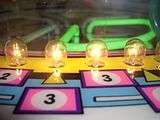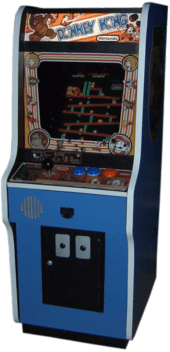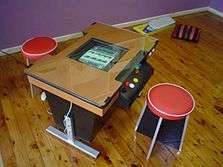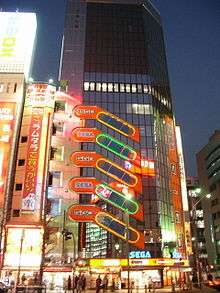Amusement arcade
An amusement arcade (often referred to as "video arcade" or simply "arcade") is a venue where people play arcade games such as video games, pinball machines, electro-mechanical games, redemption games, merchandisers (such as claw cranes), or coin-operated billiards or air hockey tables. In some countries, some types of arcades are also legally permitted to provide gambling machines such as slot machines or pachinko machines. Games are usually housed in cabinets. The term used for ancestors of these venues in the beginning of 20th century was penny arcades.[1]
Video games were introduced in amusement arcades in the late 1970s and were most popular during the golden age of arcade video games, the early 1980s. Arcades became popular with children and particularly adolescents, which led parents to be concerned that video game playing might cause them to skip school.
History
Penny arcade
A penny arcade can be any type of venue for coin-operated devices, usually for entertainment. The term came into use about 1905-1910.[1] The name derives from the penny, once a staple coin for the machines. The machines used included:[2]
- bagatelles, a game with elements of billiards and non-electrical pinball,
- early forms of non-electrical pinball machines,
- fortune-telling machinery,
- slot machines,
- coin-operated Amberolas
- peep show machines (in the original, non-pornographic, usage of the term), which allowed the viewer to see various objects and pictures
- Mutoscopes
- love tester machines.
- coin operated shooter games
Penny arcades later led to the creation of video arcades in the 1970s.
1970s and 1980s
Arcades catering for video games began to gain momentum in the late 1970s with games such as Space Invaders (1978) and Galaxian (1979) and became widespread in 1980 with Pac-Man, Centipede and others. The central processing unit in these games allowed for more complexity than earlier discrete-circuitry games such as Atari's Pong (1972).
During the late 1970s video-arcade game technology had become sophisticated enough to offer good-quality graphics and sounds, but it remained fairly basic (realistic images and full motion video were not yet available, and only a few games used spoken voice) and so the success of a game had to rely on simple and fun gameplay. This emphasis on the gameplay explains why many of these games continue to be enjoyed as of 2014, despite the progress made by modern computing technology.
The golden age of video arcade games in the 1980s became a peak era of video arcade game popularity, innovation, and earnings. Color arcade games became more prevalent and video arcades themselves started appearing outside their traditional bowling-alley and bar locales. Designers experimented with a wide variety of game genres, while developers still had to work within strict limits of available processor-power and memory. The era saw the rapid spread of video arcades across North America, Western Europe and Japan. The number of video-game arcades in North America, for example, more than doubled between 1980 and 1982,[3] reaching a peak of 13,000 video game arcades across the region (compared to 4,000 today).[4] Beginning with Space Invaders, video arcade games also started to appear in supermarkets, restaurants, liquor stores, gas stations and many other retail establishments looking for extra income.[5] This boom came to an end in the mid-1980s, in what has been referred to as "the great coin-op video crash of 1983".[6]
On November 30, 1982, Jerry Parker, the Mayor of Ottumwa, Iowa, declared his city the "Video Game Capital of the World". This initiative resulted in many firsts in video game history. Playing a central role in arcade history, Ottumwa saw the birth of the Twin Galaxies Intergalactic Scoreboard and the U.S. National Video Game Team, two organizations that still exist today. Other firsts that happened in the Video Game Capital of the World included:
- the first video-game-themed parade (Jan. 8, 1983) [7]
- the first video game world championship (Jan. 8-9, 1983) [8]
- the first study of the brain waves of video-game champions (July 12, 1983) [9]
- the first billion-point video-game performance (Jan. 16, 1984) [10]
- the first official day to honor a video-game player (Jan. 28, 1984) [11]
High game-turnover in Japanese arcades required quick game-design, leading to the adoption of standardized systems like JAMMA, Neo-Geo and CPS-2. These systems essentially provided arcade-only consoles where the video game ROM could be swapped easily to replace a game. This allowed easier development and replacement of games, but it also discouraged the hardware innovation necessary to stay ahead of the technology curve.
Most US arcades didn't see the intended benefit of this practice since many games weren't exported to the US, and if they were, distributors generally refused to release them as simply a ROM, preferring to sell the entire ROM, console, and sometimes the cabinet as a package. In fact, several arcade systems such as Sega's NAOMI board are arcade versions of home systems.
1990s
The arcade industry entered a major slump in mid-1994.[6] Arcade attendance and per-visit spending, though not as poor as during the 1983 crash, declined to the point where several of the largest arcade chains either were put up for sale or declared bankruptcy, while many large arcade machine manufacturers likewise moved to get out of the business.[6]
2000s and beyond

In the late 1990s, a bar opened in the new Crown Casino complex in Melbourne, Australia named Barcode. Barcode was a 'games bar' with the latest arcade games, the classics, pool tables, air hockey and pinball machines which you could play while consuming alcohol.[12] The bar was very popular with other bars later opening in the early 2000s in King Street alongside the strip clubs and at the shopping centre Melbourne Central. A Barcode opened in Times Square, New York in May 2000 and was very popular with the launch featuring on an episode of TV series Sex and the City.[13][14] Barcode Time Square closed in March 2003 and Barcode Crown Casino in 2006 followed later by King Street and Melbourne Central.[14][15]
In the mid-2000s, Madrid businessman Enrique Martínez updated the video arcade for the new generation by creating a "hybrid movie theater with...fog, black light, flashing green lasers, high-definition digital projectors, vibrating seats, game pads and dozens of 17-inch screens attached to individual chairs." At the Yelmo Cineplex in Spain, $390,000 was spent refitting a theater into a "high-tech video gaming hall seating about 50 people." In Germany, the CinemaxX movie theater company is also considering this approach. It conducted a four-month trial with video games to test the level of demand for video gaming in a theater setting.[16]

Manufacturers started adding innovative features to games in the 2000s. Konami used motion and position sensing of the player in Police 911 in 2000 and Mocap Boxing in 2001.[17][18] Sega started using "Tuning cards" in games such as the Initial D series of games allowing the customer to save game data on a card vended from the game; Namco copied the idea with the Maximum Tune series. Arcade games continued to use a variety of games with enhanced features to attract clients, such as motorized seating areas, interconnected games, and surround sound systems. Redemption and merchandiser games are also a staple of arcades in the 2000s. One of the most popular redemption games, Deal or No Deal by ICE, simulates the popular television game show. Merchandiser games such as Stacker by LAI Games gives the player the chance to win high end prizes like iPods and video game consoles.
At the same time as these innovations, a small resurgence in the interest of classic video games and arcades grew with the opening of Barcade in Brooklyn, New York in 2004. The simple idea of Barcade is the combination of a video arcade and a full bar, with a strict focus on classic machines from the 1970s and 1980s, known as the Golden age of video games.[19] The idea proved popular and Barcade received great recognition as one of the best places to play classic video game cabinets.[20][21] By 2011, Barcade had opened other locations in New Jersey and Philadelphia,[19] and theD company was recognized as "one of the few places where classic arcade games can still be found in public, and in good working order."[22] and also as video game "preservationists".[23] Barcade's success had also influenced many other similarly themed businesses to open across the country,[24][25] including The 1UP Arcade and Bar in Denver,[26] Insert Coin(s) in Las Vegas,[27] Arcadium in Lexington, Kentucky,[28] Headquarters Beercade in Chicago[29] and Emporium, also in Chicago, which was founded by a former manager of Barcade.[30] Other arcades like Ground Kontrol in Portland, Oregon began to adapt, adding beer and wine in 2005 and then a full bar to its arcade following a renovation in 2011.[31] Even regular types of bars began adding classic arcade games in an attempt to cash in on this trend.[32]
As the trend grew, the industry and press looked for ways to classify these arcade bar hybrids, with the DNA Association branding them "social-tainment" and also referring to them as "game bars".[33] Many of these newer game bars proved to be extremely popular and expansion continued.[34] Headquarters expanded considerably after being open only a year, adding a large pinball collection,[29] The 1UP Arcade and Bar opened a second location, called The 2UP,[35] and Insert Coin(s) attempted to go big by opening a huge location in Minneapolis,[36] before shuttering almost a year later.[37]
In the UK, classic arcades such as Casino and Trocadero, both located in London, closed, with some of the games from Trocadero finding their way to a new arcade, Heart of Gaming in North Acton.[38] The newer Loading Soho Gaming Cafe provides arcade machines manufactured by Bespoke Arcades for its customers to use.[39]
Types of games

Video games
The video games are typically in arcade cabinets. The most common kind are uprights, tall boxes with a monitor and controls in front. Customers insert coins or tokens into the machines (or use magnetic cards) and stand in front of them to play the game. These traditionally were the most popular arcade format, although presently American arcades make much more money from deluxe driving games and ticket redemption games. However, Japanese arcades, while also heavily featuring deluxe games, continue to do well with traditional JAMMA arcade video games.
Some machines, such as Ms. Pac-Man and Joust, are occasionally in smaller boxes with a flat, clear glass or acrylic glass top; the player sits at the machine playing it, looking down. This style of arcade game is known as a cocktail-style arcade game table or tabletop arcade machine, since they were first popularized in bars and pubs. For two player games on this type of machine, the players sit on opposite sides with the screen flipped upside down for each player. A few cocktail-style games had players sitting next to rather than across from one another. Both Joust and Gun Fight had these type of tables.
Racing games
Some arcade games, such as racing games, are designed to be sat in or on. These types of games are sometimes referred to as sit-down games. Sega and Namco are two of the largest manufacturers of these types of arcade games.
Other games

Other games include pinball machines, redemption games and merchandiser games. Pinball machines have a tilted, glass-covered play area in which the player uses mechanical flippers to direct a heavy metal ball towards lighted targets. Redemption games reward winners with tickets that can be redeemed for prizes such as toys or novelty items. The prizes are usually displayed behind a counter or in a glass showcase, and an arcade employee gives the items to players after counting their tickets. Merchandiser games reward winners with prizes such as stuffed toys, CDs, DVDs, or candy which are dispensed directly from the machine.
In some countries, some types of video arcades are legally allowed to provide gambling machines such as slot machines and pachinko machines. Large arcades may also have small coin-operated ride-on toys for small children. Some businesses, such as Dave & Buster's, combine a bar and restaurant with a video arcade.
Arcades typically have change machines to dispense tokens or quarters when bills are inserted, although larger chain arcades, such as Dave and Busters and Chuck E. Cheese are deviating towards a refillable card system.[40] Arcades may also have vending machines which sell soft drinks, candy, and chips. Arcades may play recorded music or a radio station over a public address system. Video arcades typically have subdued lighting to inhibit glare on the screen and enhance the viewing of the games' video displays, as well as of any decorative lighting on the cabinets.
See also
- Adult video arcade
- European Gaming & Amusement Federation
- Joypolis
- List of arcade games
- Musée Mécanique
- Pinball
- Shopping arcade
- Timeline of video arcade game history
- Video game arcade cabinet
References
- 1 2 Going out: the rise and fall of public amusements. p. 154. Retrieved 2013-05-30.
First use of the term [...] between 1905 and 1910
- ↑ "Penny Arcade Machines". Retrieved 26 June 2016.
- ↑ Mark J. P. Wolf, The video game explosion: a history from PONG to Playstation and beyond, ABC-CLIO, p. 105, ISBN 0-313-33868-X, retrieved 2011-04-19
- ↑ Mark Stephen Price (Atari Games Corporation) (1998), "Coin-Op: The Life (Arcade Videogames)" (PDF), Digital illusion: entertaining the future with high technology, ACM Press, p. 444, ISBN 0-201-84780-9, archived from the original (PDF) on 2011-07-23, retrieved 2014-10-02
- ↑ Edge Staff (2007-08-13). "The 30 Defining Moments in Gaming". Edge. Future plc. Retrieved 2008-09-18.
- 1 2 3 Webb, Marcus (February 1996). "Arcadia". Next Generation. No. 14. Imagine Media. p. 29.
- ↑ "Welcome to Twin Galaxies". 15 February 2009. Archived from the original on February 15, 2009. Retrieved 26 June 2016.
- ↑ "Welcome to Twin Galaxies". 21 February 2009. Archived from the original on February 21, 2009. Retrieved 26 June 2016.
- ↑ "Welcome to Twin Galaxies". 21 February 2009. Archived from the original on February 21, 2009. Retrieved 26 June 2016.
- ↑ "Welcome to Twin Galaxies". 15 February 2009. Archived from the original on February 15, 2009. Retrieved 26 June 2016.
- ↑ Tim McVey Day Poster, January 28, 1984
- ↑ "Barcode". Barcode bar. Archived from the original on 2007-11-03.
- ↑ "Barcode & Galactic Circus N.Y". Behance. Retrieved 8 July 2016.
- 1 2 "Remembering Barcode: NYCs Failed Arcade Club". Destructoid. Retrieved 8 July 2016.
- ↑ Porter, Ian. "Barcode goes Indian as night-life dims at Crown". The Age. 17 August 2006. Retrieved 8 July 2016.
- ↑ Carvajal, Doreen (2007-02-26). "The New Video Arcade in Spain Might Be the Movie Theater". The New York Times. Retrieved 2014-10-02.
- ↑ "Police 911 Videogame by Konami (2000) - The International Arcade Museum and the KLOV". Arcade-museum.com. Retrieved 2011-07-21.
- ↑ "MoCap Boxing Videogame by Konami (2001) - The International Arcade Museum and the KLOV". Arcade-museum.com. Retrieved 2011-07-21.
- 1 2 Weiss, Jennifer (2011-04-22). "For Arcades, Survival now Hinges on Alcohol". Wall Street Journal. Retrieved 2014-10-02.
- ↑ Solomon, Dan (2010-04-30). "The Best Video Game Bars in America". asylum.com. Retrieved 2014-10-02.
- ↑ Allen, Ted. "Best Bars: Barcade". Esquire. Retrieved 2014-10-02.
- ↑ June, Laura (2013-01-16). "For Amusement Only: The Life and Death of the American Arcade". theverge.com. Retrieved 2014-10-02.
- ↑ Parkin, Simon (2015-01-11). "Video Games and the Curse of Retro". The New Yorker.
- ↑ Ward, Getahn (2013-11-15). "New Nashville Restaurant Two Bits to Feature Classic Arcade Games". The Tennessean. Retrieved 2014-10-02.
- ↑ Levitt, Alice (2014-07-23). "Fun and Farm-to-Table Food at Tilt Arcade". sevendaysvt.com. Retrieved 2014-10-02.
- ↑ Wenzel, John (2011-05-01). "From LoDo to the Smithsonian, Video Games Get Their Due". The Denver Post. Retrieved 2014-10-02.
- ↑ Kline, Doug (2013-03-09). "Insert Coin(s) - Gaming at the Geekiest Club in Vegas". geekexchange.com. Retrieved 2014-10-02.
- ↑ Sloan, Scott (2012-11-15). "North Lexington Bar Has Retro Niche: Arcade Games". kentucky.com. Retrieved 2014-10-02.
- 1 2 Cindy (2013-04-05). "Headquarters Looks to Become Largest Pinball Arcade in Midwest". lookytasty.com. Retrieved 2014-10-02.
- ↑ Lande, Samantha (2012-02-14). "Emporium Arcade Bar Opening in March". Chicago Eater. Retrieved 2014-10-02.
- ↑ Hottle, Molly (2011-02-15). "Ground Kontrol Arcade to Reopen Thursday with Party". oregonlive.com. Archived from the original on 2013-11-10. Retrieved 2014-10-02.
- ↑ Petkovic, John (2013-04-25). "B Side Liquor Lounge in Cleveland Heights Adds Old-time Arcade Games". cleveland.com. Retrieved 2014-10-02.
- ↑ K Williams (2013-05-20). "A Nascent Trend, the Rise of the Gamebar". dna-association.com. Retrieved 2014-10-02.
- ↑ Ocean, Justin (2014-07-14). "Boozy Sleepovers and Booby Bounce Houses: Kids' Activities for Grownups". Yahoo! Travel. Retrieved 2014-10-02.
- ↑ Hendrick, Lauren (2012-05-03). "Lovers of The 1UP Arcade/Bar, Say Hello to The 2UP". Denver Eater. Retrieved 2014-10-02.
- ↑ Horgen, Tom (2012-11-03). "The Dig: A new level of gaming at new downtown club Insert Coin(s)". Star Tribune. Retrieved 2014-10-02.
- ↑ Rietmulder, Michael (2013-08-12). "Aqua Owners Buy Downtown Minneapolis' Insert Coin(s)". vita.mn. Retrieved 2014-10-02.
- ↑ Parkin, Simon (2014-08-17). "The Last Arcade". Eurogamer.net. Retrieved 2014-10-02.
- ↑ Arcade Hero Staff (2013-05-03). "LOADING SOHO Gaming Cafe Added To The MADD Bar In London". Arcade Heroes. Retrieved 2014-10-02.
- ↑ "CEC Token Card" http://www.showbizpizza.com/tokens/cards/index.html
- Bibliography
- Namerow, Wayne. The Pennyarcade Website. Retrieved 2004-02-06.
External links
| Wikimedia Commons has media related to Amusement arcades. |
- History of video games at DMOZ
- A Collection of Antique Amusement Machines
- Gameroom Show, Penny arcade related website
- PennyMachines.co.uk, British Penny Slot and Amusement Machine website
- Illustrations of various machines
- Various Penny Arcade Games with many pictures.
